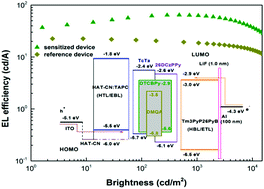High-performance fluorescent organic electroluminescent devices benefit from sensitization of thermally activated delayed fluorescence†
Abstract
Thermally activated delayed fluorescence sensitized fluorescent (TSF) organic light-emitting diodes (OLEDs) provide the possibility to simultaneously acquire a high-efficiency, noble metal-free and broadened freedom of molecular design. We aimed to further improve the electroluminescent (EL) performances of a fluorescent emitter, N,N′-dimethyl-quinacridone (DMQA), based on a TSF method by employing (3,5-bis(3,6-di-tert-butyl-9H-carbazol-9-yl)phenyl)(pyridin-4-yl)methanone (DTCBPy) as a sensitizer. In TSF devices, triplet excitons were captured by DTCBPy molecules, followed by efficient energy transfer to DMQA molecules. Besides, non-radiative loss of excitons (including direct charge trapping and undesired Dexter energy transfer) could be restrained to some extent due to the relatively high energy level of DTCBPy, extremely low co-doping concentration of DMQA and distorted structure of DTCBPy. Compared with a reference device, TSF devices displayed more attractive EL performances. Eventually, the optimized TSF device with slow efficiency roll-off acquired a maximum current efficiency (ηc,max) and external quantum efficiency (ηext,max) up to 64.3 cd A−1 and 18.3%, respectively.



 Please wait while we load your content...
Please wait while we load your content...